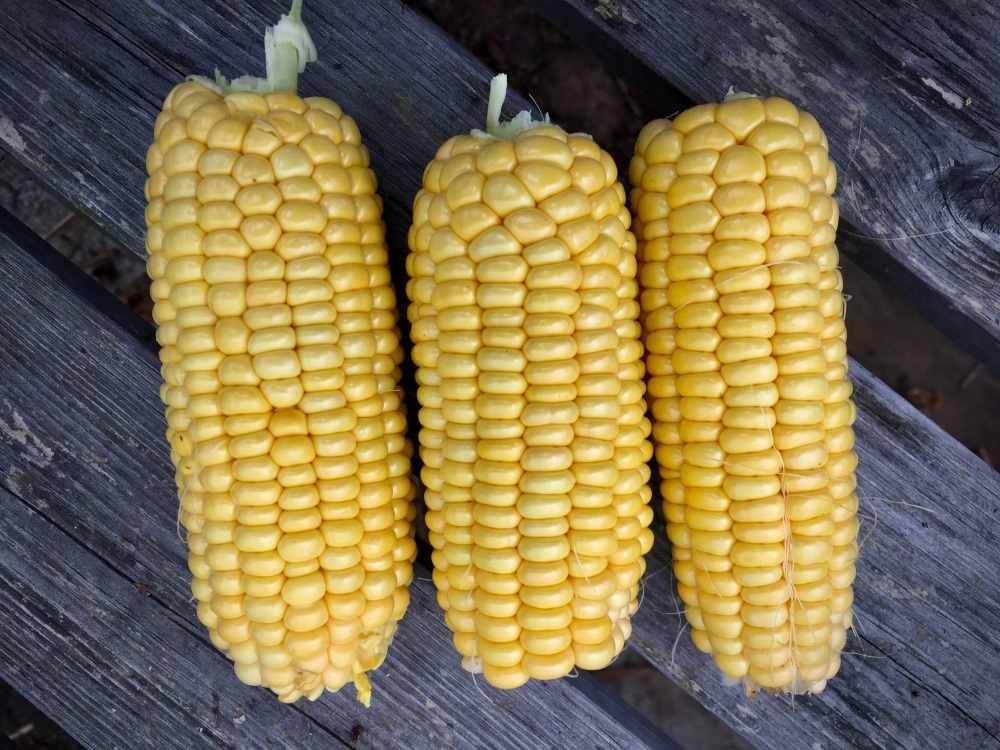I remember watching a gardening program in the 80’s where the presenter was emphasising the speed at which you needed to cook sweetcorn from the moment it was picked as the sugars started to turn to starch. In those days the only way to taste good sweet corn was to grow your own. Sweetcorn breeding has come a long way since then with the development of the tender sweet and then super sweet varieties, both of which are much sweeter and also have a longer shelf life which means no more running from plot to plate!
However the UK climate is still not ideal for sweetcorn so you need a quick growing variety. There is one sweetcorn variety that I grow every year, I have yet to find a better one and that is Swift. Swift is a tender sweet variety which means that although it isn’t as sweet as the super sweet it has the added advantages of being easier to germinate and can be grown alongside other varieties of corn (unlike super sweets) without having its taste affected which is an advantage of a mixed allotment. Swift is early to mature and you should get corn, even in a poor summer. It’s cobs are a nice individual portion size and definitely sweet enough for me, I’ve yet to taste better grown here.


In the kitchen
The best is grilled whole with a little butter on a BBQ or under a grill or lightly boiled for a few minutes and served with butter or Chilli and lime. For individual cobs slice the kernels off with a sharp knife running down the side of the hard central core. Use in salads, stir fries, Chilli or chowder. You could also try Thai Corn Cakes (Tod Man Khao Pod), Corn cakes with mango salsa or pop some in Quesadillas
Yield and plant health
You will get 1-2 medium sized cobs per plant, possibly 2-3 in the south of England. Plants are quick to mature and fairly easy to germinate. You can grow alongside other varieties without affecting flavour. No real pests and diseases other than birds and mice can attack ripening corn so you may need some protection.

Suppliers
Very widely available, a selection is below

Growing
Sweetcorn is from South America and is used to much hotter climates than ours. It is not frost hardy and also does not like root disturbance so it is important you do not start too early or else risk your plants turning up their toes!
Sweetcorn is wind pollinated. The spikes at the top of the plant pollinate the tassels on the cobs which are situated lower down. Each tassel leads to a kernel and each one needs to be pollinated for a full cob. Because of this it is better to plant sweetcorn in blocks rather than rows to maximise pollination so when choosing how many kernels to sow, think about how it will fit in to a block. You will get roughly 70-80 % successful germination of standard and enhanced sweetness varieties and less of super sweet.
Sweetcorn needs a sunny sheltered spot with free draining but nutrient rich soil. In winter give the spot where they are to grow a mulch of compost or manure and then dress with blood fish and bone meal in spring.
If you are happy to protect your outdoor crops from frost then sow one block a month before your last frost date which in the UK usually means making a mid April to early May sowing. Sow one kernal, 2 inches deep in root trainers or a 3 inch pots. Water and keep in a warm place like a heated propagator or airing cupboard until germination occurs which should be in 7-10 days. Ensure the compost is moist but not soggy. Once germination has taken place then move to a sunny but frost free spot until plants are around two inches high.
Start to harden off by placing outside during the day in a sheltered spot and bringing back in at night. Continue this for a week.
Once plants are roughly 3 inches high then you can plant out in blocks, each sweetcorn 20-30 cm apart. Water well for the first week until they are established and then generously once a week. if there is any risk of frost or windy weather, cover with fleece, lifted off the the growing corn with hoops or sticks.
Repeat sow every two weeks up to early June. You can direct sow once soil has reached 10c but will need to protect your seeds from mice who look at them as a tasty snack!
Around three weeks after you first see the tassels developing on the cobs, check to see if they are ready by peeling back a bit of the husk and pierce a cob. If the liquid runs cloudy it is ready. You should be harvesting from late July to September with successional sowing.
Alternatives
Maybe I’ll look out for swift next year. I got zero germination from my seeds this year (just a little worse than last year). I’m still trying to remember which did pretty well for me in my firsf year here – must keep better records!
LikeLike
It’s a great corn. Germinating corn can be tricky. Not too hot, not to cold, not to wet, not too dry 😂 some people presoak for an hour or so.
LikeLiked by 1 person
Sweetcorn is impossible in my garden. I’m amazed when I see farmers round here growing it!
Enjoy your own sweetcorn 😊
LikeLiked by 1 person
I completely agree with you. I now grow “Swift” rather than “Incredible”. I usually plant out about 24 plants and for two weeks in mid-September we have sweetcorn nearly everyday and no-one complains.
LikeLiked by 1 person
Glad you like it. I have tried another this year which was also good. Watch this space!
LikeLike
I have never grown sweetcorn before. I got Mr Fothergill’s Swift F1. The germination rate was 90%. We are harvesting the corn end August into September. I am very pleased with the result. Will grow Swift again next year.
LikeLike